Related Research Articles

A bong is a filtration device generally used for smoking cannabis, tobacco, or other herbal substances. In the bong shown in the photo, the gas flows from the lower port on the left to the upper port on the right.

A test tube, also known as a culture tube or sample tube, is a common piece of laboratory glassware consisting of a finger-like length of glass or clear plastic tubing, open at the top and closed at the bottom.

A sink, also known by other names including sinker, washbowl, hand basin, wash basin and simply basin, is a bowl-shaped plumbing fixture for washing hands, dishwashing, and other purposes. Sinks have taps (faucets) that supply hot and cold water and may include a spray feature to be used for faster rinsing. They also include a drain to remove used water; this drain may itself include a strainer and/or shut-off device and an overflow-prevention device. Sinks may also have an integrated soap dispenser. Many sinks, especially in kitchens, are installed adjacent to or inside a counter.

Mortar and pestle is a set of two simple tools used from the Stone Age to the present day to prepare ingredients or substances by crushing and grinding them into a fine paste or powder in the kitchen, laboratory, and pharmacy. The mortar is characteristically a bowl, typically made of hard wood, metal, ceramic, or hard stone such as granite. The pestle is a blunt, club-shaped object. The substance to be ground, which may be wet or dry, is placed in the mortar where the pestle is pounded, pressed, and rotated into the substance until the desired texture is achieved.

The Mildenhall Treasure is a large hoard of 34 masterpieces of Roman silver tableware from the fourth century AD, and by far the most valuable Roman objects artistically and by weight of bullion in Britain. It was found at West Row, near Mildenhall, Suffolk, in 1942. It consists of over thirty items and includes the Great Dish which weighs over 8 kg (18 lb).

A casserole is a variety of a large, deep pan or bowl used for cooking a variety of dishes in the oven; it is also a category of foods cooked in such a vessel. To distinguish the two uses, the pan can be called a "casserole dish" or "casserole pan", whereas the food is simply "a casserole". The same pan is often used both for cooking and for serving.

Tableware is any dish or dishware used for setting a table, serving food, and dining. It includes cutlery, glassware, serving dishes, and other items for practical as well as decorative purposes. The quality, nature, variety and number of objects varies according to culture, religion, number of diners, cuisine and occasion. For example, Middle Eastern, Indian or Polynesian food culture and cuisine sometimes limits tableware to serving dishes, using bread or leaves as individual plates. Special occasions are usually reflected in higher quality tableware.

A bowl typically is a round dish or container generally used for preparing, serving, or consuming food. The interior of a bowl is characteristically shaped like a spherical cap, with the edges and the bottom forming a seamless curve. This makes bowls especially suited for holding liquids and loose food, as the contents of the bowl are naturally concentrated in its center by the force of gravity. The exterior of a bowl is most often round but can be of any shape, including rectangular.
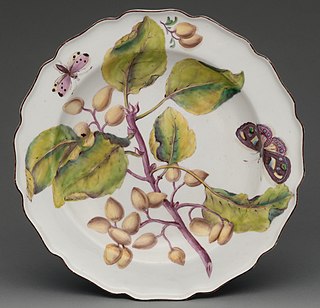
A plate is a broad, mainly flat vessel on which food can be served. A plate can also be used for ceremonial or decorative purposes. Most plates are circular, but they may be any shape, or made of any water-resistant material. Generally plates are raised round the edges, either by a curving up, or a wider lip or raised portion. Vessels with no lip, especially if they have a more rounded profile, are likely to be considered as bowls or dishes, as are very large vessels with a plate shape. Plates are dishware, and tableware. Plates in wood, pottery and metal go back into antiquity in many cultures.
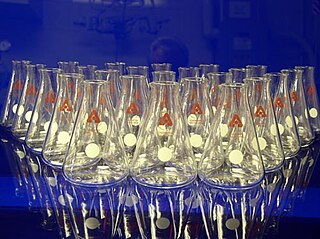
Laboratory flasks are vessels or containers that fall into the category of laboratory equipment known as glassware. In laboratory and other scientific settings, they are usually referred to simply as flasks. Flasks come in a number of shapes and a wide range of sizes, but a common distinguishing aspect in their shapes is a wider vessel "body" and one narrower tubular sections at the top called necks which have an opening at the top. Laboratory flask sizes are specified by the volume they can hold, typically in metric units such as milliliters or liters. Laboratory flasks have traditionally been made of glass, but can also be made of plastic.
A thistle tube is a piece of laboratory glassware consisting of a shaft of tube, with a reservoir and funnel-like section at the top. Thistle tubes are typically used by chemists to add liquid to an existing system or apparatus. Thistle funnels are used to add small volumes of liquids to an exact position. Thistle funnels are found with or without taps.
The batch reactor is the generic term for a type of vessel widely used in the process industries. Its name is something of a misnomer since vessels of this type are used for a variety of process operations such as solids dissolution, product mixing, chemical reactions, batch distillation, crystallization, liquid/liquid extraction and polymerization. In some cases, they are not referred to as reactors but have a name which reflects the role they perform.

A vacuum coffee maker brews coffee using two chambers where vapor pressure and gravity produce coffee. This type of coffee maker is also known as vac pot, siphon or syphon coffee maker, and was invented by Loeff of Berlin in the 1830s. These devices have since been used for more than a century in many parts of the world. Design and composition of the vacuum coffee maker varies. The chamber material is borosilicate glass, metal, or plastic, and the filter can be either a glass rod or a screen made of metal, cloth, paper, or nylon. The Napier Vacuum Machine, presented in 1840, was an early example of this technique. While vacuum coffee makers generally were excessively complex for everyday use, they were prized for producing a clear brew, and were quite popular until the middle of the twentieth century. Vacuum coffee makers remain popular in some parts of Asia, including Japan and Taiwan. The Bauhaus interpretation of this device can be seen in Gerhard Marcks' Sintrax coffee maker of 1925.
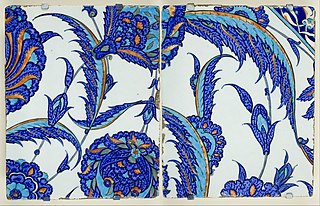
Iznik pottery, or Iznik ware, named after the town of İznik in western Anatolia where it was made, is a decorated ceramic that was produced from the last quarter of the 15th century until the end of the 17th century.

Weighing bottles are glass laboratory equipment used for precise weighing of solids.
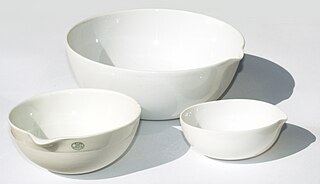
An evaporating dish is a piece of laboratory glassware used for the evaporation of solutions and supernatant liquids, and sometimes to their melting point. Evaporating dishes are used to evaporate excess solvents – most commonly water – to produce a concentrated solution or a solid precipitate of the dissolved substance.

Fruit Dish and Glass (1912), by Georges Braque, is the first papier collé. Braque and Pablo Picasso made many other works in this medium, which is generally credited as a key turning point in Cubism.
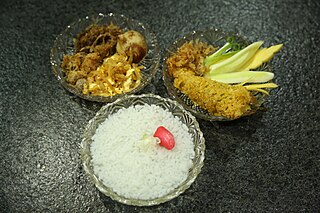
Khao chae is "rice soaked in cool water". "Khao" means "rice" and "chae" means "to soak". Around the time of King Rama II, the recipe was adapted from a Mon dish and then modified. It was meant to be made and consumed in the hot season, from mid-March to the end of April. Ice was not then available in Thailand, so the water was kept cool during hot season by putting it in an earthenware vessel in a shaded place. Some old recipes call for the use of camphor to cool the dish.
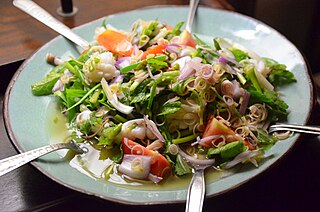
Salads that are internationally known as Thai salads, with a few exceptions, fall into four main methods of preparation. In Thai cuisine these are called yam, tam, lap and phla. A few additional dishes can also be regarded as being a salad.
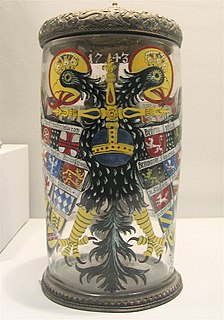
Enamelled glass or painted glass is glass which has been decorated with vitreous enamel and then fired to fuse the glasses. It can produce brilliant and long-lasting colours, and be translucent or opaque. Unlike most methods of decorating glass, it allows painting using several colours, and along with glass engraving, has historically been the main technique used to create the full range of image types on glass.